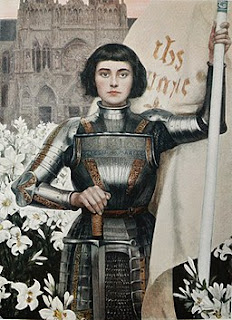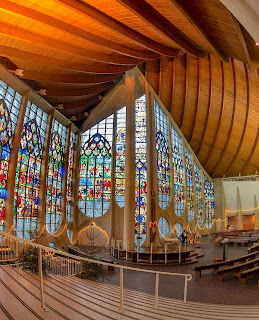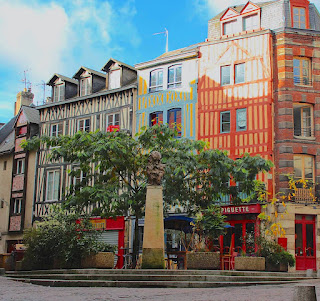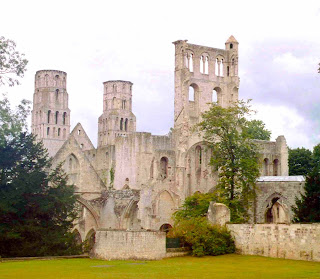 |
| Cathedral ©RNTC/JFLange |
There are so many beautiful and fascinating places to visit in France’s Normandy region, it’s hard to know where to begin, but the city of Rouen is a good place to start. While it’s the site of important French history and the birthplace of literary greats, it’s also a very vibrant, pretty place, full of life. Just wandering around Rouen's historic center of winding, cobblestone streets, ancient buildings, and picturesque, half-timbered houses, it will be love at first sight.
ARCHITECTURAL MASTERPIECES
Rouen has an amazing array of spectacular Medieval and Renaissance structures and sites, including around 2,000, splendid, timber-framed houses, some dating back to the 14th century. In fact, Rouen is classified as a Ville et Pays d’Art et d’Histoire (City of Art & History) to ensure all these buildings are preserved. Here are some not-to-be-missed highlights:
 |
| (photo: JCarnegie) |
Cathédrale Notre-Dame de Rouen
(Place de la Cathédrale/Enter: 3 Rue Saint-Romain) – It’s hard to take your eyes off this magnificent Gothic structure. The cathedral's main edifice was started in the 12th century, rebuilt in the 13th, then embellished again in the 15th- and 16th century. Impressionist artist Claude Monet painted it more than 30 times, from dawn till dusk. See for yourself how it looks at different times of day. (Check out the “Cathédrale de lumière” light show, June-Sept.)
Eglise Saint-Maclou (Place Barthélémy) – This Gothic church was built in 1437 and dedicated to Saint Malo. As lovely as the cathedral, it’s a beautiful blend of different architectural styles from Gothic to Baroque.
 |
| Saint-Maclou ©RNTC/JFLange |
Aître Saint-Maclou (186 Rue Martainville) - It’s hard to believe that this serene courtyard was once a “Black Plague” cemetery, surrounded by an ossuary. Today, it’s a nice stop to sit and recover from sightseeing. There’s a café and a little gallery highlighting ceramic works by local artists, La Galerie des Arts du Feu.
Abbatiale Saint-Ouen (Place du Général de Gaulle) - This church of Saint Ouen Abbey was part of one of the most powerful Benedictine monasteries in Normandy between the 14th and 16th centuries. Now, it’s also a site for cultural events.
Palais de Justice (36 Rue aux Juifs) - Built in the early 16th century, this magnificent building was first the Exchequer of Normandy (Court of Justice), then the Parliament of Normandy. Now, it houses Rouen's law courts (why you can’t go in for a tour, but you can stand outside and gawk).
Abbatiale Saint-Ouen (Place du Général de Gaulle) - This church of Saint Ouen Abbey was part of one of the most powerful Benedictine monasteries in Normandy between the 14th and 16th centuries. Now, it’s also a site for cultural events.
Palais de Justice (36 Rue aux Juifs) - Built in the early 16th century, this magnificent building was first the Exchequer of Normandy (Court of Justice), then the Parliament of Normandy. Now, it houses Rouen's law courts (why you can’t go in for a tour, but you can stand outside and gawk).
 |
| Gros-Horloge (photo: JCarnegie) |
Gros Horloge (Rue du Gros-Horloge) – Originally part of the adjacent, belfry tower built in 1389, the Gros Horloge (huge clock) was moved to the Renaissance arch that spans the street in 1527. The stunning, decorative, astronomical clock has two identical dials--one on each side of the arch. The clock face is a blue, starry sky with 24 golden sun-rays. The phases of the moon are indicated as are the days of the week. On the arch, sculpted sheep represent the wool industry (how Rouen became a wealthy town).
Rue de Gros-Horloge – This is one of Rouen’s main shopping streets. Along this charming, cobblestone route, lined with lovely, half-timbered houses, there’s cute boutiques and high-end stores, along with places to grab a snack. It leads to the cathedral and all the way to the Place du Vieux Marché (old market square).
Le Petit Train de Rouen (25 Place de la Cathédrale) - A really fun way to get an overview of Rouen’s town center is on this little, sightseeing train. Hop on in front of the Cathedral and head off on a 45-minute, fact-filled ride.
FRANCE’S PATRON SAINT: JOAN OF ARC
In Medieval times, during the Hundred Years War in the 15th century, English forces occupied much of northern France, including Normandy and its capital, Rouen. British King Henry V, claimed the French throne, over the embattled, French crown prince Charles of Valois (later Charles VII). A peasant girl, Jeanne d’Arc (Joan of Arc), believed that God had chosen her to lead France to victory over the English and restore Charles to the French throne. With no military training, Joan led the French army to victory over the English in the besieged city of Orléans. (Henceforth, she’d be known as "Maid of Orléans.") For this, and a succession of other victories, she was captured, ransomed to the English, and falsely-tried by French churchmen in British-ruled Rouen in 1431. Just 19 years old, Jeanne d’Arc was burnt alive on May 30, 1431 in the Place du Vieux-Marché.
Historial Jeanne d’Arc
7 Rue Saint-Romain; www.historial-jeannedarc.fr
Le Petit Train de Rouen (25 Place de la Cathédrale) - A really fun way to get an overview of Rouen’s town center is on this little, sightseeing train. Hop on in front of the Cathedral and head off on a 45-minute, fact-filled ride.
FRANCE’S PATRON SAINT: JOAN OF ARC
In Medieval times, during the Hundred Years War in the 15th century, English forces occupied much of northern France, including Normandy and its capital, Rouen. British King Henry V, claimed the French throne, over the embattled, French crown prince Charles of Valois (later Charles VII). A peasant girl, Jeanne d’Arc (Joan of Arc), believed that God had chosen her to lead France to victory over the English and restore Charles to the French throne. With no military training, Joan led the French army to victory over the English in the besieged city of Orléans. (Henceforth, she’d be known as "Maid of Orléans.") For this, and a succession of other victories, she was captured, ransomed to the English, and falsely-tried by French churchmen in British-ruled Rouen in 1431. Just 19 years old, Jeanne d’Arc was burnt alive on May 30, 1431 in the Place du Vieux-Marché.
Historial Jeanne d’Arc
7 Rue Saint-Romain; www.historial-jeannedarc.fr
 |
| Joan of Arc (artist: Albert Lynch/WikiCommons) |
This immersive experience in the archbishop’s palace is a truly-fascinating way to learn all about the historical facts and how Joan of Arc became a French icon. You’ll follow her into battle, be a witness at the heresy trial, and shutter at her brutal burning at the stake. You’ll leave understanding the true importance of her legacy to France. For it was here in this palace that her sentence was handed down in 1431 and also where the proceedings to pardon her took place in 1456, paving the way for her eventual beatification in 1909, and canonization as a saint in 1920.
Eglise Jeanne d'Arc (Place du Vieux Marché) - This contemporary-style church serves as a place of worship and a civil memorial to the French heroine. Its’ light-filled, modern interior is complemented by the spectacular, Renaissance, stained-glass windows from the former Church of Saint-Vincent.
Sur Les Pas de Jeanne d'Arc (In Joan of Arc’s Footsteps): Audio-Guide
Book an Audio-Guide in advance; pick it up at the Rouen Tourism office (25 Place de la Cathédrale)
- Do a self-guided walking tour that will take you to the Jeanne d’Arc heritage sites in Rouen: the dungeon where she was threatened with torture, the archbishop’s palace where her sentence was handed down, the Place du Vieux Marché (old market square) where she was burned at the stake, Saint-Ouen Abbey and its cemetery, and the Joan of Arc chapel in the Cathedral. (In French & English.)
Eglise Jeanne d'Arc (Place du Vieux Marché) - This contemporary-style church serves as a place of worship and a civil memorial to the French heroine. Its’ light-filled, modern interior is complemented by the spectacular, Renaissance, stained-glass windows from the former Church of Saint-Vincent.
Sur Les Pas de Jeanne d'Arc (In Joan of Arc’s Footsteps): Audio-Guide
Book an Audio-Guide in advance; pick it up at the Rouen Tourism office (25 Place de la Cathédrale)
 |
| Eglise Jeanne d'Arc ©RNTC/JFLange |
WRITERS WRIT LARGE
Rouen has been the birthplace of illustrious writers throughout the ages: Corneille wrote in the 17th century, Flaubert in the 19th century, and Maurice Leblanc (created of “Lupin”) in the 20th century—who will be the next?
Musée Pierre Corneille
4 Rue de la Pie; museepierrecorneille.fr
Pierre Corneille is generally considered one of the three great, 17th-century, French dramatists, along with Racine and Molière. His play, Le Cid, written in 1637, may be his most famous work. Born in 1606 in this house, now museum; it has a reconstruction of his study, plus furnishings, and 17th-century paintings.
Gustave Flaubert
Gustave Flaubert’s most famous novel Madame Bovary, an ill-fated romance, is also about Flaubert’s love-hate relationship with Rouen’s provincial life in the mid-1800s.
Flaubert Is Not Dead (App)Using a geolocation system, "Flaubert is not dead" outlines a route that takes about an hour, walking the streets of the city center to 8 stops. Starting at the Cathedral Square (where “Emma Bovary” had a date with her lover), additional stops include the Flaubert statue, the Lycée Pierre-Corneille where he studied, a detour to admire the bust of his friend Louis-Bouilhet, etc. The varied experiences mix archival documents, references to Flaubert’s novels, and anecdotes about the author's life. (French & English versions.)
There’s a Flaubert museum (Musée Flaubert et d'Histoire de la Médecine, 51 rue Lecat), but it’s housed in the former Hôtel-Dieu hospital where he was born and his father was head surgeon, so its’ focus is on oddball, medical treatments from the 12th to 20th century rather than on Flaubert’s literary output. (Better to download the App, even if you don’t speak French!)
Maurice Leblanc
Maurice Leblanc was born in Rouen and wrote his crime novels, featuring the
“gentleman thief” Arsène Lupin, from 1905 until the 1930s. Many of the stories feature Normandy locations such as Étretat (where you can visit his house-museum, Clos Lupin.) In Rouen, there’s a plaque on the house where he lived.
FOR ART’S SAKE
All eleven museums (Réunion des Musées Métropolitains) have free admission:
Musée des Beaux-Arts
 |
| Claude Monet painted the Cathedral from dawn till dusk. |
Esplanade Marcel-Duchamp; mbarouen.fr/en
The museum’s collection contains an extensive range of paintings, sculptures, drawings, and objets d'art from the 15th to the 21st century. Notable works include: 17th-century masterpieces by Caravaggio, Velázquez, and van Dyck; 19th-century works by Delacroix, Géricault, Delaroche, and Impressionists Monet, Sisley, Pissarro, and Renoir. Plus, Dada artist Marcel Duchamps was born nearby and went to school in Rouen; two early works are on display.
Musée de la Céramique
1 Rue Faucon; museedelaceramique.fr/en
The museum contains six thousand pieces. Along with Rouen’s renowned faïence (tin-glazed earthenware), the museum also displays lovely pieces from other ceramic centers such as Nevers and Lille, as well as Delft, 15th-century Italian majolica, and 1930s Sèvres creations, providing an overview of European ceramics.
In Situ (35 Rue Jean Lecanuet; www.insitu-restaurant.com) - Located right by the Beaux-Arts museum, this super-cool bistro is run by chef Laurent Blanchard and his wife, Patricia. Using local, farm-to-table ingredients, chef Blanchard’s culinary wizardry will make you swoon with delight. You’ll be sorry when the meal is over. It’s an extremely popular spot, so be sure to book a table in advance.
Stay: There’s an enormous choice from budget to luxury:
The museum’s collection contains an extensive range of paintings, sculptures, drawings, and objets d'art from the 15th to the 21st century. Notable works include: 17th-century masterpieces by Caravaggio, Velázquez, and van Dyck; 19th-century works by Delacroix, Géricault, Delaroche, and Impressionists Monet, Sisley, Pissarro, and Renoir. Plus, Dada artist Marcel Duchamps was born nearby and went to school in Rouen; two early works are on display.
Musée de la Céramique
1 Rue Faucon; museedelaceramique.fr/en
The museum contains six thousand pieces. Along with Rouen’s renowned faïence (tin-glazed earthenware), the museum also displays lovely pieces from other ceramic centers such as Nevers and Lille, as well as Delft, 15th-century Italian majolica, and 1930s Sèvres creations, providing an overview of European ceramics.
The Quays - Rouen is located on the Seine river, just like Paris. Recently, it’s spruced up the riverbanks to make them more accessible to the public. Parks and gardens have been created along the Left Bank, while bars, restaurants, and nightclubs line the Right Bank. Worth exploring!
Scenic Daytrip: Jumièges - The Jumièges Abbey is called “the most beautiful ruin in France.” It’s on the Route des Abbayes about a half hour from Rouen. Afterwards, enjoy a meal at the Auberge des Ruines.
Dine: The area is famous for: apples, apple cider & Calvados apple-brandy, delicious Normandy cheeses, crème fraîche (fresh cream), duck, and coquilles Saint-Jacques (scallops), among other delicacies. Lots of eateries to choose from:
Try one of the oldest and one of the hippest:
Scenic Daytrip: Jumièges - The Jumièges Abbey is called “the most beautiful ruin in France.” It’s on the Route des Abbayes about a half hour from Rouen. Afterwards, enjoy a meal at the Auberge des Ruines.
Dine: The area is famous for: apples, apple cider & Calvados apple-brandy, delicious Normandy cheeses, crème fraîche (fresh cream), duck, and coquilles Saint-Jacques (scallops), among other delicacies. Lots of eateries to choose from:
Try one of the oldest and one of the hippest:
 |
| Place Saint-Amand (Claude Monet bust) ©RNTC/JFLange |
La Couronne (31 Place du Vieux Marché; www.lacouronne-rouen.fr) - Opened in 1345 as an Inn that also served food, it’s considered the oldest auberge in France. Over time, it eventually became a gourmet restaurant. La Couronne gained prestige due to the legendary, American chef Julia Child. In 1948, Julia’s first meal in France was here. The meal was so good it inspired her to study and share her love of French cuisine. (You can order the prix-fixe Julia Child menu.)
In Situ (35 Rue Jean Lecanuet; www.insitu-restaurant.com) - Located right by the Beaux-Arts museum, this super-cool bistro is run by chef Laurent Blanchard and his wife, Patricia. Using local, farm-to-table ingredients, chef Blanchard’s culinary wizardry will make you swoon with delight. You’ll be sorry when the meal is over. It’s an extremely popular spot, so be sure to book a table in advance.
Stay: There’s an enormous choice from budget to luxury:
 |
| Jumièges Abbey ©RNTC/JFLange |
Hotel De Dieppe (1880 5 Place Bernard Tissot; www.hotel-dieppe.fr) - A very nice spot, conveniently-located right across from the train station.
Hôtel Littéraire Gustave Flaubert (33 rue du Vieux Palais; www.hotelgustaveflaubert.com) - Near the Place du Vieux Marché, each room is personalized around a work, a character, or an intimate friend of Flaubert’s.
Getting There: Take a fast, direct train (SNCF) from Paris to the Rouen Rive-Droite train station (about 1hr). Or, drive. It’s longer by car, but on the scenic route discover other lovely areas in the Normandy region, especially the charming, seaside towns on the “Côte Fleurie” (Flowery Coast).
Hôtel Littéraire Gustave Flaubert (33 rue du Vieux Palais; www.hotelgustaveflaubert.com) - Near the Place du Vieux Marché, each room is personalized around a work, a character, or an intimate friend of Flaubert’s.
Getting There: Take a fast, direct train (SNCF) from Paris to the Rouen Rive-Droite train station (about 1hr). Or, drive. It’s longer by car, but on the scenic route discover other lovely areas in the Normandy region, especially the charming, seaside towns on the “Côte Fleurie” (Flowery Coast).


No comments:
Post a Comment